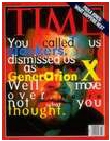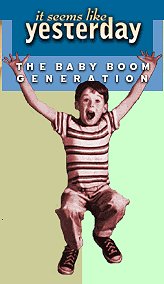On top of these natural times are built man-made times, whose rhythms increasingly shape our experiences of everyday life. Numerous "social clocks" determine our daily activities and social biographies: the timetables of our socialization (So you are 14 years of age and still in the 3rd grade? You are behind time. Loser!), courtships (We harbor doubts about those who become engaged 2 weeks after the first date and smirk at those engaged for 15 years), family life (with males' second families, retirement can precede their children's graduations from high school), and career.
Out of these various rhythms emerges a sense of life structure, featuring longer-tempo rhythms of one's career and family schedules, memories and future plans. The life structure involves the mental maps individuals have of their life-cycle, their sense of an orderly progression of life course changes. As Glenn Elder (1975, 1978) defines life course, it encompasses the `pathways' by which individuals fulfill different roles over their lives, sequentially or simultaneously. These pathways vary owing to "variations in the timing, duration, and order of events; and by the interlocking careers (in family, work) that vary in synchronization" (Elder 1985:2).
Some individuals choose to have other, more mystical times influence their life activities. These include biorhythms (don't venture too far into the real world during your "critical" days!) and astrology. Regarding the latter, a 1993 NORC random survey of American adults found some 10 percent saying "definitely true" and another 42 percent saying that it was "probably true" that astrology has some scientific truth. Click here to see Americans beliefs in astrology by age and education.
Our pathways through time are shaped by both the developmental agendas described by psychologists as well as by social and cultural factors. For instance, in Centuries of Childhood, Philippe Ariés develops how childhood was "invented" in the West as a distinctive stage of the life cycle. The appearance of children as shrunken adults wearing small adult clothing in Renaissance paintings, for instance, was not the fault of the artists but rather how children were perceived. There was no childhood as everyone had access to the same information (Neal Postman, 1982). Until the 17th century there wasn't even a word for child in French, English or German: the term referred to kinship rather than age. Aries found during Middle Ages that not only did every age group dress indiscriminately, but that there was even the lack of distinctive sex-dress for little people (16th century boys often dressed as girls). As infant mortality rates declined, for the first time in human history parents could expect to raise their children to maturity. As a result, there appeared novel cultural conceptions of this neophyte stage of social life.
And as childhood emerged with the rise of industrialism, so now the old age stage of the life-cycle is being shaped by post-industrial, service-oriented economies.
Click here to see Americans' perceptions of the best years of the life-cycle.
It is demeaning to the nation that within the Clinton administration a corps of the elite who never grew up, never did anything real, never sacrificed, never suffered and never learned, should have the power to fund with your earnings their dubious and self-serving selves.
According to Alvin Toffler in Future Shock, time is replacing space as the major divider of people in modern societies. The intersections between biographical time and social-historical time in periods of rapid socio-cultural change are suspected of producing distinctive outlooks and values among differently-aged individuals. Such impacts of social history on identity structures underlies social science research on generations.
There are several senses of the generational concept (and several generational archetypes). In Biblical times, generations were units to demarcate eras. We still use this sense when referring to some massive historical event (like the Vietnam War, the Civil Rights era, World War II, or the Depression) that collectively affects those age groups early in their life-cycles. While precisely where in the life-cycle individuals are most susceptible to such historical influences is a matter of debate--child psychologist Jerome Kagan argues that it's the 6-16 group most influenced by such sociological changes, while sociologist Glenn Elder claims that the defining period is when a cohort is first entering the labor market--the assumption is nevertheless made that an historical thumbprint is permanently impressed.
A related notion involves generations as birth cohorts, as when referring to those born during the 1930s (which was a relatively small cohort owing to the grim economics at the time of their birth, and now that group entering old age) or the 1970s (the beginning of the so-called "baby-boom echo"). Consider the proposition that one must be 10 years of age or older before socio-historical events create lasting memories. If that be the case, in 2005:
The sense of "generation" that perhaps most intrigues Americans is the notion of generations as historically-conscious agents of social change. As developed by Karl Mannheim in 1920, with modernization there's an increase in historical watershed events (such as war, depression, or famine), that leads to different social realities experienced by different generations within different stages of life development. Each century may see three or four such generations, attracting adjacent cohorts as a magnet attracts magnetic filings. As Maurice Halbwachs observed in The Collective Memory (1950), these are the groups "that develop the reigning conceptions and mentality of a society during a certain period [and then] fade away in time, making room for others, who in turn command the sway of custom and fashion opinion from new models." Two such generations that have received considerable publicity are the postwar Baby Boomers and members of the so-called Generation X. So how truly different are they? When comparing these two generations several factors need to be taken into account: First, any comparison must control for their location in the life-cycle, requiring that we look at the Boomers in the 1970s and Xers in the 1990s. Second, we must take into account the general socio-cultural climate when our two snapshots in time are taken. For instance, if we were to compare the political leanings of these two generations when in their twenties, we must compensate for the fact that the times are more conservative in the 1990s than they were in the 1970s. Click here to see the basic trust in others held by Boomers and Xers
It was the end of the century. The world was in chaos. Nations worked furiously to subvert other nations. Men and women were confused about their place and purpose. The country was amidst the ravages of a deadly, sexually-transmitted epidemic. Myriad were the double agents, impostors, and traitors who reveled in the tumult. Even the faithful were corrupt, producing a moral backlash. Populism was making a return as the gap between the haves and have-nots was reaching an extreme.Sound familiar? No, it is not a summary of our times but rather a description of the ending of the nineteenth century at the conclusion of the Guilded Age--a time in the West of great urban homelessness, of sexual revolutions and epidemics, and of upheaval in gender roles.
Given the thesis of these pages that most of the times of our lives have a cyclical quality, it should come as no surprise that parallels should arise in the life experiences of certain generations. The most notable elaboration of this argument in recent years is William Strauss and Neil How's Generations: The History of America's Future (William Morrow, 1991). The authors (two Boomer historians who initially wondered if another generation like theirs ever existed in American society) contend that four types of generations, each with its own salient character traits, have recurred throughout American history. Causing this four generation sequence are (a) regular 40-45-year cycles of secular and spiritual social movements, and (b) a supposed human tendency of human beings to correct for the perceived excesses of their elders by raising their progeny in a manner opposite the way they themselves were brought up. The secular crises arise when society focuses on ways to reorder its institutions and public behavior; the spiritual reawakenings are those periods when the social focus is on altering personal values and private behaviors. Nurturing styles shift from relaxed to rigid and then from underprotective to overprotective, with each style laying down a "peer personality" matrix for each new generation.
The result of such
social
cycles and socialization tendencies are two dominant generations sandwiched
between two recessive generations. During social movements the dominant
generations are entering rising adulthood and elderhood while the recessive
generations are entering youth and the midlife years. So you were born
in the mid-1970s? Your generational clones are the Cavalier (born 1615-1647),
Liberty (1724-1741), Gilded (1822- 1842), and Lost (1883-1900)
generations.



 Return to Times of Our Lives Index
Page
Return to Times of Our Lives Index
Page